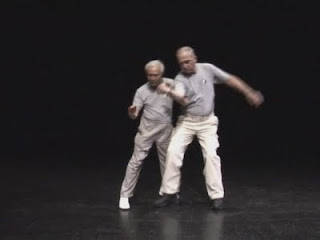The left shoulder of Master Master Stephen Hwa "offsets" the opponents' equilibrium, observation shows this."Shouldering" is 靠 (kào). The pronunciation is something like "cow."The meaning of 靠 (kào) in Tai Chi is to use your body to bump or press against something. "Shoulder" is used, but the word "Kao" actually does not mean "shoulder" specifically. It seems "old" as a word, perhaps traditional where "one word is used for many things* as Master Hwa has explained "The teacher forgot his keys and used "Kao" from his back to get into the office", unfortunately rendering the door useless, Master Hwa used "Kao" with his shoulder to bump his tall student Jim Roach. Master Stephen Hwa used Kao with his back to bump someone's chest that tried to get him in a bearhug from behind. Sifu Jim Roach was carrying a package and had to move a chair out of the way by using "Kao" to bump it with his derriere. Jack Eichel body checked the opponent into the "boards", and in Chinese, this would be called "Kao Not shown for Master Wu is only the beginning of and not how fluid a followup move to Part the Wild Horse’s Mane 野馬分鬃. Note the position of Master Wu's left knee as a "fulcrum". I did this application with classmates at Wu's Tai Chi Academy in Toronto quite a bit...very adaptable and efficient.
Wednesday, May 20, 2020
靠 (kào) Shoulder
The left shoulder of Master Master Stephen Hwa "offsets" the opponents' equilibrium, observation shows this."Shouldering" is 靠 (kào). The pronunciation is something like "cow."The meaning of 靠 (kào) in Tai Chi is to use your body to bump or press against something. "Shoulder" is used, but the word "Kao" actually does not mean "shoulder" specifically. It seems "old" as a word, perhaps traditional where "one word is used for many things* as Master Hwa has explained "The teacher forgot his keys and used "Kao" from his back to get into the office", unfortunately rendering the door useless, Master Hwa used "Kao" with his shoulder to bump his tall student Jim Roach. Master Stephen Hwa used Kao with his back to bump someone's chest that tried to get him in a bearhug from behind. Sifu Jim Roach was carrying a package and had to move a chair out of the way by using "Kao" to bump it with his derriere. Jack Eichel body checked the opponent into the "boards", and in Chinese, this would be called "Kao Not shown for Master Wu is only the beginning of and not how fluid a followup move to Part the Wild Horse’s Mane 野馬分鬃. Note the position of Master Wu's left knee as a "fulcrum". I did this application with classmates at Wu's Tai Chi Academy in Toronto quite a bit...very adaptable and efficient.
Subscribe to:
Post Comments (Atom)
Droop & Slinky (Sink)
Droop & Sink Vertically Video Link A student some time ago asked me via email: "How does the second generation of Wu's fa...

-
Very interesting post! But my Taiwanese sources tell me, that Xiong Yanghe's Taijiquan has many origins, from some nephew of Yang Luch...
-
Yielding Sit Back Video Link When I “Take the opponent higher” I sit back but there is a “tilt”. I am in “sit back” and yielding” in respo...



No comments:
Post a Comment